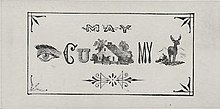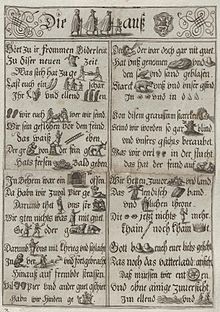This articleneeds additional citations forverification.(August 2021) |
Arebus(/ˈriːbəs/REE-bəss) is apuzzledevice that combines the use of illustrated pictures with individual letters to depict words or phrases. For example: the word "been" might be depicted by a rebus showing an illustrated bumblebee next to a plus sign (+) and the letter "n".


It was a favourite form ofheraldicexpression used in theMiddle Agesto denote surnames. For example, in its basic form, threesalmon(fish) are used to denote the surname "Salmon".A more sophisticated example was the rebus of BishopWalter Lyhart(d. 1472) of Norwich, consisting of astag(orhart) lying down in a conventional representation of water. The composition alludes to the name, profession or personal characteristics of the bearer, and speaks to the beholderNon verbis, sed rebus,whichLatinexpression signifies "not by words but by things"[1](res, rei(f), a thing, object, matter;rebusbeingablativeplural).[2]
Rebuses within heraldry
editRebuses are used extensively as a form of heraldic expression as a hint to the name of the bearer; they are not synonymous withcanting arms.A man might have a rebus as a personal identification device entirely separate from his armorials, canting or otherwise. For example,Sir Richard Weston(d. 1541) bore as arms:Ermine, on a chief azure fivebezants,whilst his rebus, displayed many times in terracotta plaques on the walls of his mansionSutton Place, Surrey,was a "tun" or barrel, used to designate the last syllable of his surname.
An example of canting arms proper are those of theBorough of Congletonin Cheshire consisting of acongereel, a lion (in Latin,leo) and a tun (barrel). This word sequence "conger-leo-tun" enunciates the town's name. Similarly, the coat of arms ofSt. Ignatius Loyolacontains wolves (in Spanish,lobo) and a kettle (olla), said by some (probably incorrectly) to be a rebus for "Loyola". The arms ofElizabeth Bowes-Lyonfeaturebowsand lions.
Modern rebuses, word plays
editA modern example of the rebus used as a form ofword playis:
By extension, it also uses the positioning of words or parts of words in relation to each other to convey a hidden meaning, for example:
- p walk ark:walk in the park.
A rebus made up solely of letters (such as "CU" for "See you" ) is known as agramogram,grammagram, or letteral word. This concept is sometimes extended to include numbers (as in "Q8" for "Kuwait",or" 8 "for" ate ").[3]Rebuses are sometimes used incrosswordpuzzles, with multiple letters or a symbol fitting into a single square.[4]
Pictograms
editThe termrebusalso refers to the use of apictogramto represent a syllabic sound. This adapts pictograms intophonograms.A precursor to the development of the Alpha bet, this process represents one of the most important developments of writing. Fully developed hieroglyphs read in rebus fashion were in use atAbydosin Egypt as early as 3400 BCE.[5]In Mesopotamia, the principle was first employed onProto-Cuneiformtablets, beginning in theJemdet Nasr period(c. 3100–2900 BC).[6][7]
The writing of correspondence in rebus form became popular in the eighteenth century and continued into the nineteenth century.Lewis Carrollwrote the children he befriended picture-puzzle rebus letters, nonsense letters, andlooking-glassletters, which had to be held in front of a mirror to be read.[8]Rebus letters served either as a sort ofcodeor simply as apastime.
Rebus principle
editInlinguistics,therebus principleis the use of existing symbols, such as pictograms, purely for their sounds regardless of their meaning, to represent new words. Many ancient writing systems used what we now term 'the rebus principle' to represent abstract words, which otherwise would be hard to represent with pictograms. An example that illustrates the Rebus principle is the representation of the sentence "I can see you" by using the pictographs of "eye—can—sea—ewe".
Some linguists believe that the Chinese developed their writing system according to the rebus principle,[9]and Egyptian hieroglyphs sometimes used a similar system. A famous rebus statue ofRamses IIuses three hieroglyphs to compose his name:Horus(asRa), forRa;the child,mes;and the sedge plant (stalk held in left hand),su;the name Ra-mes-su is then formed.[10]
Sigmund Freud[11]posited that the rebus was the basis for uncovering the latent content of thedream.He wrote, "A dream is a picture puzzle of this sort and our predecessors in the field of dream interpretation have made the mistake of treating the rebus as a pictorial composition: and as such it has seemed to them nonsensical and worthless."
Use in game shows
editCanada
- 1980s children's game showKidstreetfeatured a rebusduring the bonus round (or "final lap" ).
United Kingdom
- Catchphraseis a long-running game show which requires contestants to decipher a rebus. The show began as a short-livedAmerican game showhosted byArt Jamesbefore being seen in the United Kingdom from 1986 to 2004 and returning in 2013. There was also anAustralian versionof the show hosted byJohn Burgess.
- In 1998, Granada TV producedWaffle,a single word rebus puzzle show that was hosted by Nick Weir, and included premium telephone line viewer participation.
United States
- Rebuses were central to the television game showConcentration.Contestants had to solve a rebus, usually partially concealed behind any of thirty numbered "squares", to win a game. An updated version, known asClassic Concentration,shrank the board to twenty-five squares. There were also British and Australian versions of the game.
- TheHBOchildren's game seriesCrashboxfeatures three rebus puzzles in the game segment "Ten Seconds."
- A short-lived ABC game show from 1965 known asThe Rebus Gamealso involved contestants creating rebuses to communicate an answer.
- TheNickelodeongame showGet the Picturefeatures a Power Surge called "Rebus Mania", in which the teams had 30 seconds to guess the rebus that was shown.
India
- Dadagiri Unlimitedis a game show in which some rebus puzzles are used in thegoogly round.The show is broadcast byZee Banglaand hosted by the former Indian cricketerSourav Ganguly.
Historical examples
edit- It is reported[13]that whenVoltairewas the guest ofFrederick the GreatatSanssouci Palace,they exchanged puzzle notes. Frederick sent over a page with two picture blocks on it: two hands below the letter P, and then the number 100 below a picture of a handsaw, all followed by a question mark. Voltaire replied with:Ga!
- Both messages were rebuses in the French language:deux mains sous Pé à cent sous scie?"two hands under 'p' at [one] hundred under saw" =demain souper à Sanssouci?"supper tomorrow at Sanssouci?" ); reply:Gé grand, A petit!"big 'G', small 'a'!" (=j'ai grand appétit!"I am very hungry!" ).
- The early sixteenth-centuryBishop of Exeter,Hugh Oldham,adopted the owl as his personal device. It bore a scroll in its beak bearing the letters D.O.M., forming a rebus based on his surname, which would probably have been pronounced at the time asowl-dom.[14]
- The nineteenth-century French sculptorJean-Pierre Dantanwould place rebuses on thesoclesof his caricature busts to identify the subject. For example,Victor Hugowas an axe (hachein French, which sounds like the French pronunciation of "H" ) + UG + crossed bones (os,sounding like "O" ).Hector Berliozwas represented by the letters BER low on the socle, with a bed (lit,for "li" ) comparatively high on the socle (to mean "haut",the French for high, pronounced with a silent" h "and" t "and the digraph" au "sounding like" O ").[15]
- Rebus Bibles such asA Curious Hieroglyphic Biblewere popular in the late eighteenth century for teaching children to read the Bible.[16]
- Franciscansinteracting withNahuatl-speaking groups found that the Cholultecans used rebus principles to record information in Latin. The Cholultecans learned the Pater Noster or Lord's Prayer with the aid of drawing pictures of apantli(flag or banner) to representpaterand a picture of a prickly pear,nochtli,fornoster.This practice was seen as a strength of the people's pictographic literacy.[17]
Japan
editIn Japan, the rebus known ashanjimono(Phán じ vật)[18]was immensely popular during theEdo period.[19]A piece byukiyo-eartistKunisadawas "Actor Puzzles" (Yakusha hanjimono) that featured rebuses.[20]
Today the most often seen of these symbols is a picture of a sickle, a circle, and the letternu(ぬ),read askama-wa-nu(Liêm luân ぬ,sickle circlenu),interpreted askamawanu(Cấu わぬ),the old-fashioned form ofkamawanai(Cấu わない,don't worry, doesn't matter).This is known as thekamawanu-mon(Liêm luân nô văn,kamawanu sign),and dates to circa 1700,[21]being used in kabuki since circa 1815.[22][23]
Kabukiactors would wearyukataand other clothing whose pictorial design, in rebus, represented theirYagō"guild names", and would distributetenuguicloth with their rebused names as well. The practice was not restricted to the acting profession and was undertaken by townsfolk of various walks of life. There were also pictorial calendars calledegoyomithat represented theJapanese calendarin rebus so it could be "read" by the illiterate.
Today a number of abstract examples following certain conventions are occasionally used for names, primarily for corporatelogosor product logos and incorporating some characters of the name, as in amonogram;seeJapanese rebus monogram.The most familiar example globally is the logo forYamasasoy sauce, which is a ∧ with a サ under it. This is read asYama,foryama(Sơn,mountain)(symbolized by the ∧) +sa(サ,katakana character forsa).
Rebus puzzles on US beers
edit- Lone Starhas rebus puzzles under thecrown capsof its bottled beer, as doNational Bohemian,Lucky Lager,Falstaff,Olympia,Rainier,Haffenreffer,Kassel,Pearl,Regal,Ballantine,Mickey's,Lionshead,and Texas Pride during the 1970s and the 1980s. These puzzle caps are also called "crown ticklers".[24]Narragansett Beeruses rebus puzzles on their bottle caps, and bar coasters.[25]
See also
edit- Dingbat,another word for rebus, derived from thegame of the same name
- Emoji
- Verbal arithmetic
- Visual pun
References
edit- ^Boutell, Charles,Heraldry Historical & Popular,London, 1863, pp. 117–120
- ^Cassell's Latin Dictionary,ed. Marchant & Charles
- ^"Cryptic crossword reference lists > Gramograms".Highlight Press.Retrieved31 December2016.
- ^Deb Amlen."How to Solve The New York Times Crossword".The New York Times.Retrieved12 December2017.
- ^Fischer, Steven Roger, "A History of Writing", 2004, Reaktion Books,ISBN1-86189-167-9,ISBN978-1-86189-167-9,at page 36
- ^DeFrancis, John (1989).Visible Speech: The Diverse Oneness of Writing Systems.Honolulu, Hawaii: University of Hawaii Press. p. 75.ISBN978-0-8248-1207-2.
- ^Woods, Christopher (2010). "The earliest Mesopotamian writing". In Woods, Christopher (ed.).Visible language. Inventions of writing in the ancient Middle East and beyond(PDF).Oriental Institute Museum Publications. Vol. 32. Chicago: University of Chicago. pp. 33–50.ISBN978-1-885923-76-9.
- ^Dawn Comer (3 January 1998)."Lewis Carroll Centenary Article".Niles Daily Star.Archived fromthe originalon 13 May 2007.
- ^The Languages of China.S. Robert Ramsey. Princeton University Press, 1987, p. 137.
- ^The pharaohs.Ziegler, Christiane. London: Thames & Hudson. 2002.ISBN9780500051191.OCLC50215544.
{{cite book}}:CS1 maint: others (link) - ^Freud, S. (1900)The Interpretation of DreamsLondon: Hogarth Press
- ^Boutell, Charles(1863).Heraldry, Historical and Popular(2nd ed.). London: Winsor and Newton. p.118.
- ^Danesi, Marcel(2002).The Puzzle Instinct: The Meaning of Puzzles in Human Life(1st ed.). Indiana, USA: Indiana University Press. p. 61.ISBN0253217083.
- ^Moss, John."Manchester Celebrities – Philanthropy, Philosophy & Religion – Bishop Hugh Oldham".ManchesterUK. Archived from the original on 16 January 2013.Retrieved3 January2011.
{{cite web}}:CS1 maint: unfit URL (link) - ^"The Art Tribune –Jean-Pierre Dantan (1800–1869), Louis-Hector Berlioz, 1833".Thearttribune.Retrieved14 January2019.
- ^"A Curious Hieroglyphick Bible".American Treasures of the Library of Congress.Library of Congress. Archived fromthe originalon 9 October 2015.Retrieved31 January2015.
- ^Mendieta, G. de (1971).Historia Eclesiastica Indiana[A religios History of the Indians]. Mexico, DF: Editorial Porrua (Original work published 1945)
- ^Hepburn, James Curtis (1873).A Japanese-English and English-Japanese Dictionary.A.D.F. Randolph.
- ^Ihara, Saikaku(1963).Morris, Ivan(ed.).The Life of an Amorous Woman: And Other Writings.A.D.F. Randolph.ISBN978-0-8112-0187-2.,p.348, note 456,
- ^Izzard, Sebastian; Rimer, J. Thomas; Carpenter, John T. (1993).Kunisada's world.Japan Society, in collaboration with Ukiyo-e Society of America.ISBN978-0-913304-37-2.,p. 23
- ^"Từ điển ・ bách khoa sự điển の kiểm tác サービス – Weblio sách tra cứu".Arquivo.pt. Archived fromthe originalon 25 May 2016.Retrieved14 January2019.
- ^[1]Archived17 August 2013 at theWayback Machine
- ^"Lữ から lữ văn dạng sự điển BBS".Tabikaratabi.pro.tok2.Retrieved20 June2015.
- ^Alan J. Switzer."Puzzle Beer Caps".Jokelibrary.net. Archived from the original on 22 September 2012.Retrieved14 March2013.
{{cite web}}:CS1 maint: unfit URL (link) - ^"Rebus Puzzles".Narragansett Beer.
External links
edit- How to solve Rebus puzzles.
- An example of usingchinese-likecharacters to write English.
- The online music reviewLa Foliaoffersrebuses derived from composers' names
- Online rebus generators, automatically convert any text into a rebus:
- festisite
- rebus.clubHigh quality generator due to the use of a special purposeEdit distancealgorithm.
- rebus1.
- Collection of interestingRebus Puzzles
- Reading Rebus Project